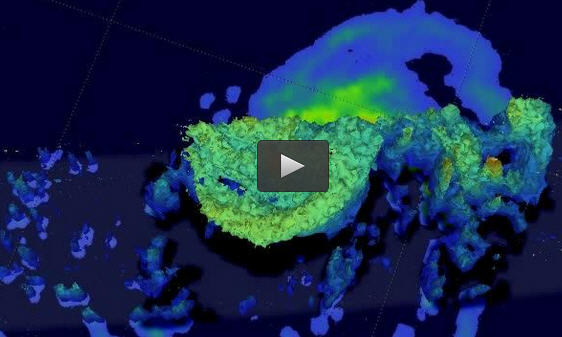NASA looks at rare Arabian Sea tropical cyclone in 3-D

This GPM core satellite 3-D view of tropical cyclone Ashobaa revealed the storm had very powerful thunderstorms near the center of the newly formed storm reaching heights above 17 km (10.5 miles). Courtesy of SSAI/NASA/JAXA, Hal Pierce
The GPM core observatory satellite flew over Ashobaa on the morning of June 8 at 0811 UTC (4:11 a.m. EDT). Tropical cyclone Ashobaa had sustained wind speeds of about 40 knots (46 mph) when the satellite passed overhead.
On June 9 at 0900 UTC (5 a.m. EDT), tropical cyclone Ashobaa had maximum sustained winds near 50 knots (57.5 mph/92.6 kph). Ashobaa was centered near 20.7 north latitude and 64.1 east longitude, about 290 nautical miles (333.7 miles/ 537.1 km) south-southwest of Karachi, Pakistan. Ashobaa is moving west-northwest at 8 knots (9.2 mph/14.8 kph).
Satellite data on June 9 showed that the storm is tightly wrapped, although elongated as clouds and showers are being pushed to the west because of persistent moderate easterly wind shear.
The Joint Typhoon Warning Center (JTWC) predicts that tropical cyclone Ashobaa will become more powerful and have winds of 65 knots (about 75 mph) by June 10 as it moves through warm sea surface temperatures. Ashobaa is then predicted to weaken as dry stable air is expected to affect the system. It is forecast to turn west where it expected to make landfall on June 12 near Ras al Hadd, a village in the Ash Sharqiyah district in Oman.
As Ashobaa continues curving to the west in the Arabian Sea, it is generating rough surf along the coasts of Oman, southeastern Iran and Pakistan.
GPM's Microwave Imager (GMI) and Dual-Frequency Precipitation Radar (DPR) instruments measured rain falling at a rate of over 60 mm (2.3 inches) per hour in strong thunderstorms southwest of the storm's center of circulation.
###
At NASA's Goddard Space Flight Center in Greenbelt, Md., a 3-D view was constructed using data from DPR Ku band radar data. The 3-D view of GPM revealed Ashobaa had very powerful thunderstorms near the center of the newly formed storm reaching heights above 17 km (10.5 miles). These tall thunderstorms near the center of a tropical cyclone can be as sign that intensification will occur in the future.
Media Contact
All latest news from the category: Earth Sciences
Earth Sciences (also referred to as Geosciences), which deals with basic issues surrounding our planet, plays a vital role in the area of energy and raw materials supply.
Earth Sciences comprises subjects such as geology, geography, geological informatics, paleontology, mineralogy, petrography, crystallography, geophysics, geodesy, glaciology, cartography, photogrammetry, meteorology and seismology, early-warning systems, earthquake research and polar research.
Newest articles

A universal framework for spatial biology
SpatialData is a freely accessible tool to unify and integrate data from different omics technologies accounting for spatial information, which can provide holistic insights into health and disease. Biological processes…

How complex biological processes arise
A $20 million grant from the U.S. National Science Foundation (NSF) will support the establishment and operation of the National Synthesis Center for Emergence in the Molecular and Cellular Sciences (NCEMS) at…

Airborne single-photon lidar system achieves high-resolution 3D imaging
Compact, low-power system opens doors for photon-efficient drone and satellite-based environmental monitoring and mapping. Researchers have developed a compact and lightweight single-photon airborne lidar system that can acquire high-resolution 3D…





















